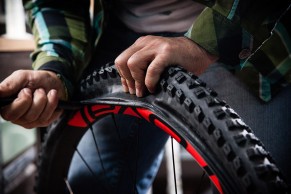When must the tubeless tire sealant be replaced? What quantity?
Have you already decided to install tubeless on your wheels? It's certainly a good decision, you'll notice how it reduces almost any risk of a flat tire, so with the tubeless tire sealant you'll be more relaxed in your mind. But it brings you more. However, if you don't know how much tubeless tire sealant to use, or when to change it because you notice that it is no longer as efficient, here we solve these and other similar doubts.

When and why to put tubeless tire sealant
We are considering that you already use tubeless tire sealant, isn't that right? Don't worry, placing it is relatively simple if you don't want to go to a workshop. You can insert the tubeless tire sealant directly into the wheel through the access provided by the valve. However, before injecting the tubeless tire sealant you should know that if you have a Schraeder or a Presta valve, the process is similar (remove the shell so that it gives unrestricted access) but it is done with different spanners. There are thousands of tutorials on YouTube, it's simple, don't worry.
But here what we try to solve is when and why to change the tubeless tire sealant.
RECOMENDADO

Guidelines for a perfect and safe tanned cyclist

How much money a cyclist can make in the Tour de France 2024?

Ketone, the drink of military origin for which Dumoulin quits the MPCC

Benefits of not drinking a drop of alcohol

Puncture-proof SmartMousse for mountain bike, do you need it?

Daysaver, a multi-tool of only 45g

Firstly, there is no standard time. For example, if the tubeless tire sealant works very well for you, you will only need to replace it when you change tires, especially if you take advantage of the disassembly to do so, because then it would be more complicated. But if you do not spend so much rubber, perhaps about 3 months is a prudent time to stick a review of your levels and quality of tubeless tire sealant.
The quantity, if it is only a replacement of tubeless tire sealant, will be around 80 millilitres. Note down the figure, because it is valid for mountain bikes but also for roads, although we recommend a little less on the road and a little more tubeless tire sealant on fat MTB wheels.
Recommended doses for mountain bikes according to the size of the wheel:
- MTB 26″: between 60-80 ml
- MTB 27,5″: between 80-100 ml
- MTB 29″: between 90-120 ml
- Fat Bike: between 170-200 ml

It is very important that in this filling, especially if it is a filling of tubeless tire sealant after a tire change, you make sure before you have properly heeled the tire, if you do not want bad experiences and waste of tubeless tire sealant.
And how do I maintain my wheels with tubeless tire sealant
Less flat tires, better pressure adjustment because it avoids losses and a slight improvement in weight. The advantages of tubeless tire sealant are well known. But how to do the maintenance?

First of all, check your tire pressure often. They are a good witness, a good alarm in case something goes wrong. If the sealant has done its job and sealed, or if it hasn't and the wheel has lost air, adjusting this pressure will help you detect that something is wrong. Maybe it's a simple pore, that's the most probable thing, but it's better to be on guard in case it's something more serious.

But tubeless tire sealant can also suffer small evaporations and lose capacity and properties over time. That is why we indicated those 3 months of prudential time. It depends a lot on the use, because maybe you have not checked it for half a year and you think it is going great. And it is possible, but we give values of prudential revision, not of punctual cases.

One last piece of advice. It seems simple, but it's useful: move the wheels from time to time and stick your ear in (you can't hear it with your feet). You will hear the movement of the tubeless tire sealant and, in time, you will be able to identify the approximate amount that remains just by hearing it.
And if you haven't tried tubeless tire sealant on your bike wheels, really try it. Who hasn't had a couple of flat tires ruin their ride? And this is more than avoidable, isn't it?